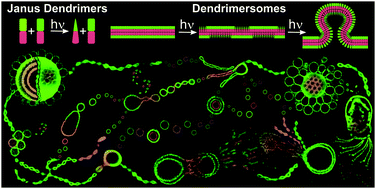Abstract
The vital functions of cell membranes require their ability to quickly change shape to perform complex tasks such as motion, division, endocytosis, and apoptosis. Membrane curvature in cells is modulated by very complex processes such as changes in lipid composition, the oligomerization of curvature-scaffolding proteins, and the reversible insertion of protein regions that act like wedges in the membrane. But, could much simpler mechanisms support membrane shape transformation? In this work, we demonstrate how the change of amphiphile topology in the bilayer can drive shape transformations of cell membrane models. To tackle this, we have designed and synthesized new types of amphiphiles—Janus dendrimers—that self-assemble into uni-, multilamellar, or smectic-ordered vesicles, named dendrimersomes. We synthesized Janus dendrimers containing a photo-labile bond that upon UV-Vis irradiation cleavage lose a part of the hydrophilic dendron. This leads to a change from a cylindrically to a wedge-shaped amphiphile. The high mobility of these dendrimers allows for the concentration of the wedge-shaped amphiphiles and the generation of transmembrane asymmetries. The concentration of the wedges and their rate of segregation allowed control of the budding and generation of structures such as tubules and high genus vesicles.

- This article is part of the themed collection: Remodelling of Biomembranes


 Please wait while we load your content...
Please wait while we load your content...
